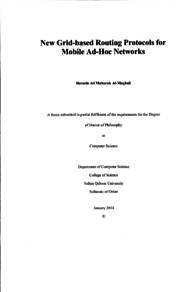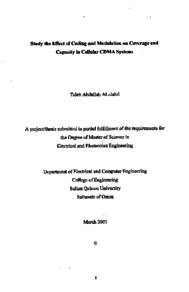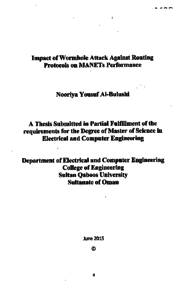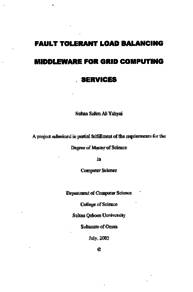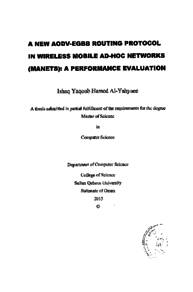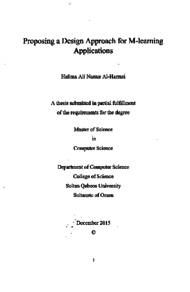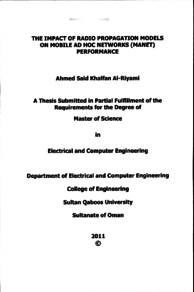وثيقة
New grid-based routing protocols for mobile Ad-Hoc networks
الناشر
Sultan Qaboos University
ميلادي
2014
اللغة
الأنجليزية
الموضوع
الملخص الإنجليزي
Much research has been conducted on Mobile Ad Hoc Networks (MANETs) over the past decade due to the rapid advances in wireless communication technology and the wide potential applications of MANETs in many walks of life. A lot of research effort has been devoted to developing efficient MANET routing protocols that exhibit low overhead during path discovery and maintenance. In particular, grid-based routing protocols have been shown to incur a low overhead by exploiting a logical two-dimensional grid structure over the topological terrain which helps identifying paths between source and destination nodes in a cost-effective manner. Most previous grid routing protocols are based on the well-known GRID protocol. This protocol is in turn based on the well-known reactive AODV protocol over a backbone of cell-heads; one cell head from cach cell in the 2D-grid structure. A cell-head is elected in each cell using a specific cell-head election mechanism. Moreover, a data packet travels from source to destination by hopping repeatedly from one cell to another adjacent cell until it reaches its destination. Existing grid-based routing protocols suffer from drawbacks including inefficient election mechanisms that use a high number of control packets causing high end-to-end delay; inefficient use of the transmission range of the nodes by restricting the packet movement to adjacent cells: and the lack of utilizing the available alternative paths. In the first part of this thesis, I propose and evaluate a new cell-head election mechanism in order to reduce overhead due to control packets and improve delivery ratio and end-to-end packet delays, The routing protocol resulting from the new election mechanism is referred to as Efficient Grid based Routing Protocol (EGRP). Our approach is to use regular control packets (including route request and route reply packets) for piggybacking information required for cell-head election as well as a special table at each node for storing minimal information about neighbouring nodes. In existing grid-based protocols, including our proposed EGRP, a packet travels from a cell to another with a restriction that the two cells have to be adjacent. I show that this restriction could affect negatively system performance, especially in sparse environments where there are many empty cells. To address this shortcoming, I suggest an enhancement to EGRP where such a restriction is relaxed. Our simulation results show that this helps reducing overhead and improves packet delivery ratios. In the second part of this thesis, I propose a novel grid-based routing approach which combines the desirable features of both proactive and reactive routing protocols in order to achieve higher performance levels. The approach divides the routing protocol model into two layers. The first is a proactive layer where a cell-based shortest-path tree is constructed. The second is a reactive layer where paths to destinations are established making use of the constructed shortest-path tree. I propose a new protocol called Trec-based Grid Routing (TGRP) based on the proposed two-layer approach. I have developed a mathematical model for studying the performance of TGRP compared to other grid-based routing protocols (GRID and EGRP). The results show the superiority of TGRP especially in terms of reduced overhead and end-to-end packet delays. During the course of my research, I have designed and implemented simulation models and conducted extensive simulation experiments using the NS2 network simulation tool. In these simulations I have analysed the performance of my proposed routing protocols under a variety of network density, traffic load and node mobility conditions. I have collected statistics on the following performance measures: end-to-end packet delay, control overhead, and packet delivery ratio. In most considered scenarios, results reveal that my proposed protocols lead to great improvements in the performance of grid-based protocols with respect to the adopted measures
الوصف
Thesis
المجموعة
URL المصدر
الملخص العربي
لقد أجريت الكثير من البحوث على الشبكات اللاسلكية العشوائية (MANET) على مدى العقد الماضي بسبب التقدم السريع في تكنولوجيا الاتصالات اللاسلكية والتطبيقات المحتملة الواسعة في كثير من مناحي الحياة. وقد كرست الكثير من الجهود البحثية لتطوير كفاءة بروتوكولات التوجيه التي تظهر انخفاضا في التكلفة العامة خلال اكتشاف مسار التوجيه وصيانته. وقد أثبتت بروتوكولات التوجيه لبنية الشبكة ثنائية الأبعاد انخفاض التكلفة العامة وذلك من خلال استغلال بنية الشبكة ثنائية الأبعاد على التضاريس الطوبوغرافية مما يساعد على تحديد المسارات بين المصدر والوجهة بطريقة فعالة. وتستند معظم بروتوكولات التوجيه السابقة المبنية على الشبكة ثنائية الأبعاد على البروتوكول المعروف ب GRID . هذا البروتوكول يعمل على أساس البروتوكول AODV عن طريق انتخاب ممثل عن كل خلية . وينتخب ممثل في كل خلية باستخدام آلية محددة. علاوة على ذلك، تنتقل حزم البيانات من المصدر إلى الوجهة من خلال القفز تكرارا من خلية إلى خلية مجاورة لها حتى تصل إلى وجهتها. بنية الشبكة ثنائية الأبعاد المستندة إلى بروتوكولات التوجيه الحالية تعاني من عيوب مثل آلية انتخاب الممثل للخلية الذي يتسبب في التأخير ويتطلب عدد كبير من حزم التحكم ؛ كما أن الشبكة الحالية لا تستفيد استفادة كاملة من نطاق الإرسال للأجهزة المتنقلة بسبب تقييد الحركة من خلية إلى الخلايا المجاورة فقط ، وكما أنها لا تستفيد من المسارات البديلة المتوفرة في الشبكة في الجزء الأول من هذه الأطروحة ، اقترحت و قیمت آلية جديدة لانتخاب ممثل الخلية من أجل الحد من التكلفة العامة بسبب حزم التحكم المساعدة وأدي ذلك إلى تحسين نسبة حزم البيانات المسلمة ومتوسط وقت تسليم الحزم، يشار إلى أن بروتوكول التوجيه الناتج عن آلية انتخاب ممثل الخلية الجديدة والمسمى (EGRP) أثبت كفاءة عالية مقارنة ببروتوكول التوجيه (GRID). نهجنا هو الاستخدام الأمثل لحزم التحكم المساعدة الموجودة لتبادل المعلومات المطلوبة لانتخاب ممثل الخلية وبناء جدول خاص في كل جهاز متنقل لتخزين حد أدنى من المعلومات عن الأجهزة المتنقلة المجاورة. في البروتوكولات المبنية على الشبكة ثنائية الأبعاد ، تتنقل حزمة المعلومات من خلية إلى أخرى مع التقيد بالتحرك من خلية إلى الخلية المجاورة لها. وتبين لنا أن هذا التقييد يمكن أن يؤثر سلبا على أداء بروتوكول التوجيه ، ولا سيما في البيئات ذات الكثافة القليلة للأجهزة المتنقلة حيث تكون هناك العديد من الخلايا الفارغة . لمعالجة هذا القصور اقترحت تعزيز البروتوكول الEGRP بحيث نسمح لحزم المعلومات بالقفز على الخلايا المجاورة الفارغة. وتظهر نتائج المحاكاة في أن هذا يساعد على تقليل التكلفة وتحسين نسب حزم البيانات المستلمة في الجزء الثاني من هذه الأطروحة ، اقترحت إضافة طبقتين لبرتوكولات التوجيه على بنية الشبكة ثنائية الأبعاد أحدها استباقي والآخر تفاعلي وبالتالي نجمع بين ميزات كل من بروتوكولات التوجيه الاستباقية والتفاعلية من أجل تحقيق أعلى مستويات الأداء، ويتم ذلك بتقسيم نموذج بروتوكول التوجيه إلى طبقتين: الأولى هي الطبقة الاستباقية حيث يتم إنشاء شجرة أقصر المسارات. والثانية هي الطبقة التفاعلية حيث تحدد المسارات إلى الوجهات بالاستفادة من شجرة أقصر المسارات. واقترحت بروتوكولا جديدا تحت مسمى TGRP مبنيا على مبدأ الشجرة والشبكة ثنائية الأبعاد وبالاستناد إلى نهج الطبقتين. قمت أيضا بتطوير نموذج رياضي لدراسة أداء البروتوكول TGRP بالمقارنة مع غيره من بروتوكولات التوجيه على الشبكة بما في ذلك GRID و EGRP ولقد أظهرت النتائج تفوق TGRP خاصة من حيث انخفاض التكلفة العامة والوقت المستهلك لإيصال الحزم. من خلال البحث، قمت بتصميم وتنفيذ نماذج محاكاة وإجراء العديد من تجارب المحاكاة بشكل مكثف باستخدام أداة المحاكاة الشبكية NS2 في هذه التجارب قمت بتحليل أداء بروتوكولات التوجيه المقترحة في إطار مجموعة متنوعة من المتغيرات بما في ذلك كثافة الشبكة ، وأعباء الشبكة، وسرعة تحرك الأجهزة المتنقلة. ولقد جمعت إحصائيات عن مقاييس الأداء التالية: الوقت المستهلك لتوصيل الحزم، و عدد حزم التحكم المستخدمة، ونسبة تسليم الحزم. وفي أكثر السيناريوهات التي تم محاكاتهاء أظهرت النتائج أن البروتوكولات الجديدة المقترحة في هذه الأطروحة تؤدي إلى تحسينات كبيرة في الأداء
قالب العنصر
الرسائل والأطروحات الجامعية

